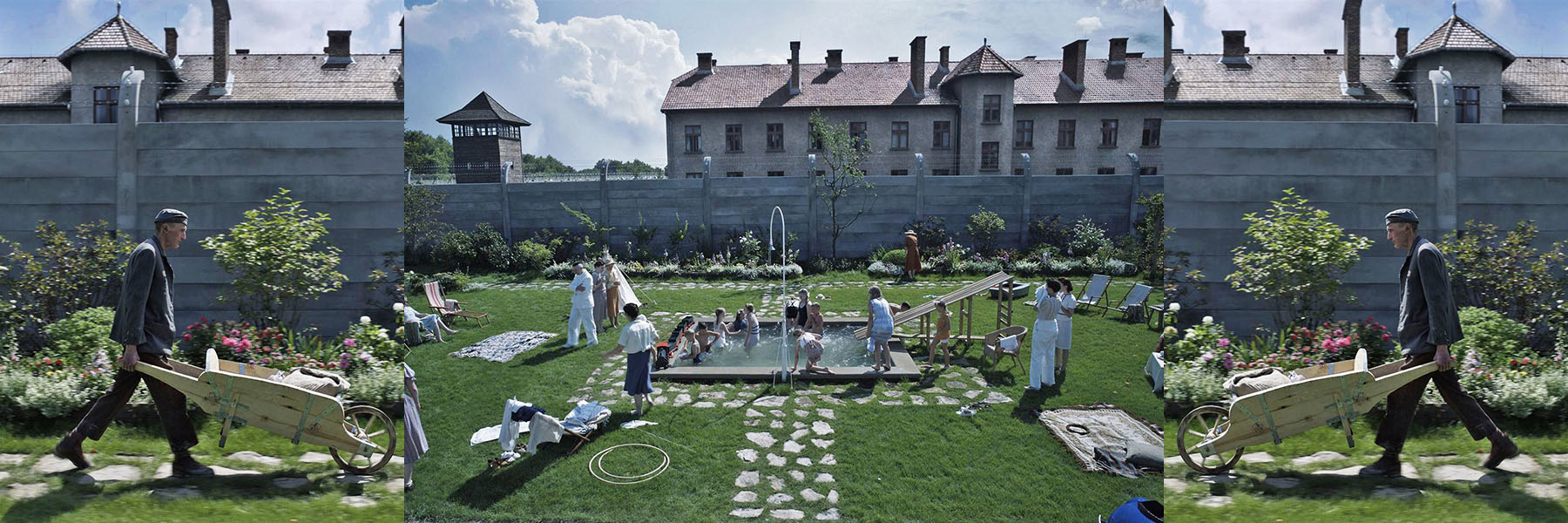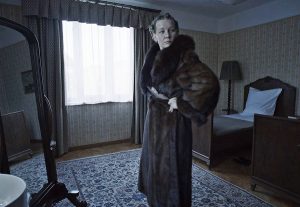Neu im Kino – The Zone of Interest
Von Holger Jacobs
18.03.2024
Wertung: 🙂 🙂 🙂 🙂 (vier von fünf)
Die „Banalität des Grauens“, dargestellt in einem Film
Viel wurde bisher über JONATHAQN GLAZERS Film „The Zone of Interest“ geschrieben.
Bereits bei dem Internationalen Filmfestival in Cannes im Mai letzten Jahres (kultur24 berichtete), wo der Film uraufgeführt wurde, galt er als Favorit für die Goldene Palme.
Letztlich ging der Hauptpreis aber an einen anderen wichtigen Europäischen Film, an „Anatomie eines Falls“ (und jetzt einen Oscar für das Beste Drehbuch).
Doch „The Zone of Interest“ bekam in Cannes zumindest den Großen Preis der Jury.
Bei der diesjährigen Oscar-Verleihung gab es dann eine goldene Statue als Bester Film in einer ausländischen Sprache und für den Besten Ton.
Wie gut ist der Film „The Zone of Interest“?
Nun, es kommt darauf an, was der Zuschauer erwartet, bzw. was er sehen möchte.
Möchte der Zuschauer Unterhaltung, fällt der Film durch.
Will er aber ein intelligent gemachtes Kammerspiel mit einem dramatischen Unterton und historischem Bezug, ist er bei „The Zone of Interest“ genau richtig.
Dadurch, dass man schon im Vorfeld so viel über den Film gehört und gelesen hat (der Film zeigt den Lagerkommandanten von Auschwitz Rudolf Höß und seine Familie im Alltag in deren Haus direkt neben dem Konzentrationslager, ohne dabei den Holocaust selbst zu sehen) ist schon einmal viel an Spannung verloren.
Und so sieht der Zuschauer eben diese Familie, historisch genau in der damaligen Kleidung, im Hair-Styling, in Verhaltensweisen untereinander und den Räumlichkeiten.
Da JONATHAN GLAZER nicht in dem heute noch erhaltenen Kommandantenhaus drehen durfte, da dieses sich heute in Privatbesitz befindet (wer kauft eigentlich so ein Haus…?), ließ er durch seinen Set-Designer CHRIS ODDY ein sich in der Nähe befindliches leer stehendes Haus so umbauen, dass es dem Original so weit wie möglich entsprach. Einschließlich des Gartens, der im Film eine größere Rolle spielt.
Dieses Familienleben ist die ersten 10 Minuten ganz interessant zuzusehen, verliert aber danach mehr und mehr an Interesse, weil eigentlich nichts passiert. Die Kinder spielen im Garten, die Ehefrau Hedwig (SANDRA HÜLLER) lädt zum Kaffeekränzchen und der Mann geht zum Angeln (der Fluss färbt sich während seines Angelns grau von der Asche der Krematorien). Dabei sieht man nie das KZ selber (außer seiner Mauer und die darüber hinausragenden Dächer), noch Häftlinge oder Gräueltaten. Nur ab und zu hört man weit entfernt Schüsse oder die Schreie von Häftlingen. Und am Abend die hochlodernden Flammen der Krematorien.
Der einzige Höhepunkt kommt etwa nach der Hälfte des Films:
Rudolf Höß (CHRISTIAN FRIEDEL) soll in das KZ Oranienburg versetzt werden, wogegen sich die Ehefrau Hedwig (SANDRA HÜLLER) vehement sträubt, da sie sich doch so „schön“ in Auschwitz eingerichtet hat. Sie erreicht, dass sie mit ihren Kindern bleiben darf, während ihr Mann alleine nach Oranienburg zieht.
Dort angekommen wird Rudolf Höß die Endlösung für die ungarischen Juden erklärt, die nun (wir schreiben das Jahr 1943) zu Tausenden per Zug in Viehwagen nach Auschwitz transportiert werden sollen. Tag und Nacht. Diese logistische Herausforderung gilt es für das KZ Auschwitz-Birkenau zu meistern, weshalb er zu seiner alten Wirkungsstätte zurückkehren soll.
Am Ende sieht man Rudolf Höß (wurde nach dem Krieg 1947 durch ein polnisches Gericht zum Tode durch den Strang, ausgeführt in Auschwitz, verurteilt) am Abend langsam die halbdunklen Gänge eines Regierungsgebäudes entlang gehen, wobei er sich ständig umdreht, als würde verfolgt.
Parallel dazu werden in der Schlusssequenz die Ausstellungsräume des heutigen Auschwitz einschließlich des Krematoriums gezeigt, in denen eine Reinigungsmannschaft den Dreck der Touristen wegwischt.
Fazit: Mir hat der Film nur teilweise gefallen.
Die Idee ist toll (eine sehr freie Adaption des gleichnamigen Romans von 2014 des britischen Schriftstellers Martin Amis), aber auf die Dauer wird dieses Familienleben langweilig.
Und CHRISTIAN FRIEDEL als Rudolf Höß spielt doch sehr platt, als würde er gar nicht dazugehören.
Der Academy Award für den Besten Ton kommt übrigens nicht von ungefähr:
Die Lautstärke der Schüsse und der Schreie aus dem KZ hinter der Mauer sind angeblich penibel genau nach Entfernung und Räumlichkeit von Toningenieur JOHNNIE BURN eingestellt worden. Und jeder Übergang in eine andere Szenerie, einschließlich des Prologs und des Epilogs, sind mit einer ganz bestimmten Geräuschkulisse von dem Komponisten MACI LEVI untermalt, die äußerst bedrohlich wirkt und für sich schon jedes Mal eine Art kleinen Höhepunkt darstellt.
Bilderserie mit 10 Fotos aus „The Zone of Interest“:
English text
New in the cinema – The Zone of Interest
By Holger Jacobs
The “banality of horror” portrayed in a movie
A lot has been written about JONATHAQN GLAZER’s film “The Zone of Interest”.
Already at the International Film Festival in Cannes in May last year (kultur24 reported), where the movie premiered, it was considered the favorite for the Palme d’Or.
Ultimately, the main prize went to another important European film, “Anatomy of a Case” (and now an Oscar for Best Screenplay).
But “The Zone of Interest” at least got the Grand Jury Prize in Cannes.
And at this year’s Oscars there was a gold statue for Best Film in a Foreign Language and for Best Sound.
How brillant is the movie “The Zone of Interest”?
Well, it depends on what the viewer expects or what he wants to see.
If the viewer wants entertainment, the film fails.
But if you want an intelligently made chamber piece with a dramatic undertone and historical reference, “The Zone of Interest” is the right choice.
Because you have already heard and read so much about the movie in advance (the film shows the Auschwitz camp commandant Rudolf Höß and his family in everyday life in their house right next to the concentration camp), a lot of the tension is lost.
And so the viewer sees this family, historically accurate in the clothing of the time, in the styling of the hair, in their behavior towards one another and in the rooms.
Since JONATHAN GLAZER was not allowed to film in the commandant’s house that was still preserved, as it is now privately owned (who actually buys a house like that…?), he left a nearby one empty through his set designer (CHRIS ODDY).
Remodel the standing house so that it corresponded as closely as possible to the original. Including the garden, which plays a larger role in the film.
This family life is quite interesting to watch for the first 10 minutes, but then it loses more and more interest because nothing actually happens.
The children play in the garden, the wife Hedwig (SANDRA HÜLLER) invites people to a coffee party and the husband goes fishing (the river turns gray from the ashes of the crematoria while he is fishing).
You never see the concentration camp itself (except for its wall and the roofs that protrude above it), nor any prisoners or atrocities.
Only now and then can you hear shots or the screams of prisoners in the distance.
And in the evening the blazing flames of the crematoria.
The only climax comes about halfway through the movie:
Rudolf Höß (CHRISTIAN FRIEDEL) is to be transferred to the Oranienburg concentration camp, which his wife Hedwig (SANDRA HÜLLER) vehemently resists because she has settled in so “nicely” in Auschwitz.
She manages to be allowed to stay with her children while her husband moves to Oranienburg alone.
Once there, Rudolf Höß is explained the final solution for the Hungarian Jews, thousands of whom are now to be transported to Auschwitz by train in cattle cars (the year is 1943). Day and night.
This logistical challenge must be mastered by the Auschwitz-Birkenau concentration camp, which is why he should return to his old place of work.
At the end you see Rudolf Höß (who was sentenced to death by hanging in Auschwitz after the war in 1947 by a Polish court) walking slowly down the half-dark corridors of a government building in the evening, constantly turning around as if he were being followed.
At the same time, the final sequence shows the exhibition rooms of today’s Auschwitz, including the crematorium, where a cleaning crew wipes away the tourists‘ dirt.
Conclusion: I only partially liked the movie.
The idea is great (a very loose adaptation of the 2014 novel of the same name by British writer Martin Amis), but in the long run this family life becomes boring.
And CHRISTIAN FRIEDEL as Rudolf Höß plays very flatly, as if he doesn’t belong there at all.
By the way, the Academy Award for Best Sound is no coincidence:
The volume of the shots and screams from the concentration camp behind the wall were supposedly meticulously adjusted according to distance and spatiality by sound engineer JOHNNIE BURN. And every transition into a different scenery, including the prologue and the epilogue, is accompanied by a very specific background noise by composer MACI LEVI, which seems extremely threatening and always represents a kind of small climax.
Picture series with 10 photos of „The Zone of Interest“:
Author: Holger Jacobs
Founder & Editorial Director of kultur24.berlin ug.
Founder & Editorial Director of kultur24 TV on Youtube.
Former correspondent for fashion in Paris.
Photographer, writer and filmmaker.












